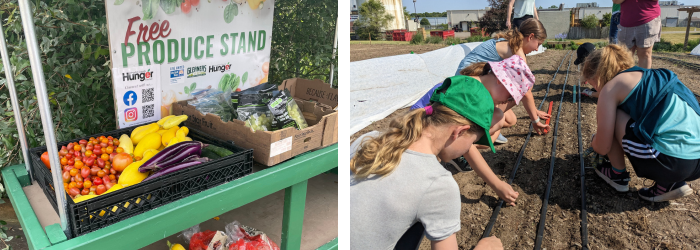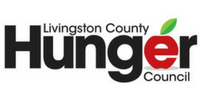Who We Are

The Livingston Hunger Council is a collaborative body made up of a cross-section of the community dedicated to ending hunger in Livingston County. The Council is made up of government agencies, non-profits, local businesses and private citizens who have committed to making our community a place where everyone has access to the nutritious food they need, when they need it.
Our Values
We believe:
- That all people deserve to be engaged and treated with dignity and respect
- That all people deserve access to food that is nutritious, and dietarily appropriate for them and their family
- In working collaboratively with all members of the community to increase effectiveness and efficiency, and reduce barriers to food security
- That all people deserve accurate and timely information about food access and nutrition
- That we must be proactive and responsive to an ever-changing landscape of food security
Our Mission
Together we nourish and educate our community by championing food access and education to promote a healthy life for all.
Our Vision
We envision a community where all residents have access to nutritious food and are empowered to live healthier, full lives of self-reliance and dignity.
Our History
THE PROBLEM: Hunger exists in Livingston County
- An estimated 17,850 neighbors (10% of the population) are “food insecure”.
(“Map the Meal Gap 2013”, Feeding America) - High risk populations, those with the lowest levels of education and income, have significantly increased occurrences of high cholesterol, hypertension, obesity, and diabetes.
- The Michigan Blueprint to End Hunger, a study released by the Food Bank Council in 2007, identified a 51% gap (5 million meals) in Livingston County – in food available to local families living in poverty.
THE SOLUTION:
- January, 2008 – Livingston County Basic Needs Workgroup, a collaborative body working to address the basic needs of the community, reviewed the report, and commissioned Alexander Resources to conduct a local study of food insecurity and access issues.
- May, 2008 – One of the key recommendations from that study involved bringing together people from across different sectors of the community, who were passionate about addressing hunger, to form the Livingston County Hunger Council – working in four quadrants (*optimize government programs*strengthen private food programs*empower people to make healthier choices*create community-based solutions) – to fill “the gap” and eliminate hunger in Livingston County.
- October, 2009 – The “Council” brought together grocers, businesses, chamber of commerce, Human Services Collaborative Body, Department of Human Services, Department of Public Health, Head Start, County Commissioners, MSU Extension, a fast food restaurant, agencies representing WIC, government commodity programs, and senior nutrition meals on wheels, a nursery, master gardeners, United Way, a hospital, Gleaners Community Food Bank, school lunch programs, community food pantries, and faith-based organizations.
- December, 2009 – Committees were formed, and the first year’s goal was set – an additional 3.5 million meals by 2010 year-end, with 1.5 million of those meals as a direct result of the Council’s activities.
THE RESULTS: 2010
- Gleaners/OLHSA partnership (the first in the state) has improved accessibility, delivery, and efficiency across emergency and commodity food programs.
- Community Gardens produced over 10,000 pounds of produce in the first season.
- Raised the federal Food Assistance Program utilization from 27.1% in 2007 to 51.6% in 2010.
- Created and distributed a generic Free & Reduced Lunch application for all county schools.
- Raised community awareness of the hunger problem in Livingston County.
- Secured its first grant award.
- Provided a total of 3,855,423 additional meals over 2009 levels – reducing the gap by 77%
2011 BUILT A BETTER SYSTEM
- Engaged community “Summer Lunch Bunch” sponsors to serve even more low-income children.
- Established a local food pantry network of coordinated services across the county.
- Integrated nutrition education with food programs – “Shopping Matters” and “Cooking Matters”.
- Further expanded “Community Gardens” through community events and new partnerships.
- Developed a new website – www.livingstonhunger.com
2012 ENGAGED THE COMMUNITY
- Created a “Faith-Based Initiative” to support and sustain the local food pantry network.
- Continued to work with area schools to provide more nutritious meals to food-insecure children.
- Significantly increased the availability of local, fresh, quality produce through multiple channels – community garden partnerships; EBT acceptance at farmers’ markets; grow-a-row, produce carts, and other projects to involve those who live or work here in becoming part of the solution.
- Provided another 3.1 million meals, virtually eliminating the meal gap!
2013-2015 BUILDING ON A STRATEGIC PLAN FOR THE FUTURE
- Received recognition from the Governor and elected state officials for being the 1st Hunger-Free community in the state.
- Hosted a viewing of “A Place at the Table” along with a panel discussion.
- Working on implementation of 5 strategic plan sustainable strategies:
1. Shaping a Hunger Council to enable it to support a system that is responsive to change.
2. Influence culture to value nutrition.
3. Localize food future
4. Elevate communication at all levels.
5. Strengthen and support targeted population initiatives.
2015-2017 SUSTAIN THE ENVIRONMENT OF A HUNGER-SECURE LIVINGSTON COUNTY
- Council is the expert, voice, convener, and advocate for food-insecurity, hunger issues, and strategic solutions in Livingston County.
- Influence local culture to value nutrition.
- Improve nutritional density in local food programs and initiatives.
- Strengthen, expand, and sustain the safety net of high-quality initiatives and programs.
Last Updated 9/7/23
